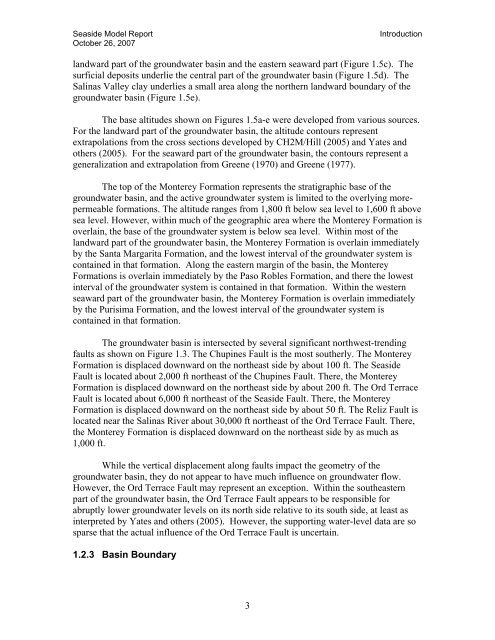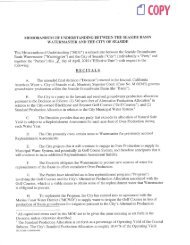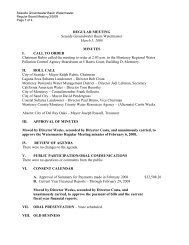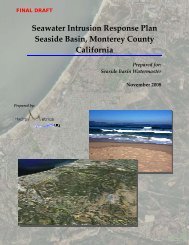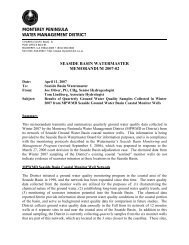groundwater flow and transport model seaside groundwater basin ...
groundwater flow and transport model seaside groundwater basin ...
groundwater flow and transport model seaside groundwater basin ...
You also want an ePaper? Increase the reach of your titles
YUMPU automatically turns print PDFs into web optimized ePapers that Google loves.
Seaside Model Report<br />
October 26, 2007<br />
Introduction<br />
l<strong>and</strong>ward part of the <strong>groundwater</strong> <strong>basin</strong> <strong>and</strong> the eastern seaward part (Figure 1.5c). The<br />
surficial deposits underlie the central part of the <strong>groundwater</strong> <strong>basin</strong> (Figure 1.5d). The<br />
Salinas Valley clay underlies a small area along the northern l<strong>and</strong>ward boundary of the<br />
<strong>groundwater</strong> <strong>basin</strong> (Figure 1.5e).<br />
The base altitudes shown on Figures 1.5a-e were developed from various sources.<br />
For the l<strong>and</strong>ward part of the <strong>groundwater</strong> <strong>basin</strong>, the altitude contours represent<br />
extrapolations from the cross sections developed by CH2M/Hill (2005) <strong>and</strong> Yates <strong>and</strong><br />
others (2005). For the seaward part of the <strong>groundwater</strong> <strong>basin</strong>, the contours represent a<br />
generalization <strong>and</strong> extrapolation from Greene (1970) <strong>and</strong> Greene (1977).<br />
The top of the Monterey Formation represents the stratigraphic base of the<br />
<strong>groundwater</strong> <strong>basin</strong>, <strong>and</strong> the active <strong>groundwater</strong> system is limited to the overlying morepermeable<br />
formations. The altitude ranges from 1,800 ft below sea level to 1,600 ft above<br />
sea level. However, within much of the geographic area where the Monterey Formation is<br />
overlain, the base of the <strong>groundwater</strong> system is below sea level. Within most of the<br />
l<strong>and</strong>ward part of the <strong>groundwater</strong> <strong>basin</strong>, the Monterey Formation is overlain immediately<br />
by the Santa Margarita Formation, <strong>and</strong> the lowest interval of the <strong>groundwater</strong> system is<br />
contained in that formation. Along the eastern margin of the <strong>basin</strong>, the Monterey<br />
Formations is overlain immediately by the Paso Robles Formation, <strong>and</strong> there the lowest<br />
interval of the <strong>groundwater</strong> system is contained in that formation. Within the western<br />
seaward part of the <strong>groundwater</strong> <strong>basin</strong>, the Monterey Formation is overlain immediately<br />
by the Purisima Formation, <strong>and</strong> the lowest interval of the <strong>groundwater</strong> system is<br />
contained in that formation.<br />
The <strong>groundwater</strong> <strong>basin</strong> is intersected by several significant northwest-trending<br />
faults as shown on Figure 1.3. The Chupines Fault is the most southerly. The Monterey<br />
Formation is displaced downward on the northeast side by about 100 ft. The Seaside<br />
Fault is located about 2,000 ft northeast of the Chupines Fault. There, the Monterey<br />
Formation is displaced downward on the northeast side by about 200 ft. The Ord Terrace<br />
Fault is located about 6,000 ft northeast of the Seaside Fault. There, the Monterey<br />
Formation is displaced downward on the northeast side by about 50 ft. The Reliz Fault is<br />
located near the Salinas River about 30,000 ft northeast of the Ord Terrace Fault. There,<br />
the Monterey Formation is displaced downward on the northeast side by as much as<br />
1,000 ft.<br />
While the vertical displacement along faults impact the geometry of the<br />
<strong>groundwater</strong> <strong>basin</strong>, they do not appear to have much influence on <strong>groundwater</strong> <strong>flow</strong>.<br />
However, the Ord Terrace Fault may represent an exception. Within the southeastern<br />
part of the <strong>groundwater</strong> <strong>basin</strong>, the Ord Terrace Fault appears to be responsible for<br />
abruptly lower <strong>groundwater</strong> levels on its north side relative to its south side, at least as<br />
interpreted by Yates <strong>and</strong> others (2005). However, the supporting water-level data are so<br />
sparse that the actual influence of the Ord Terrace Fault is uncertain.<br />
1.2.3 Basin Boundary<br />
3


